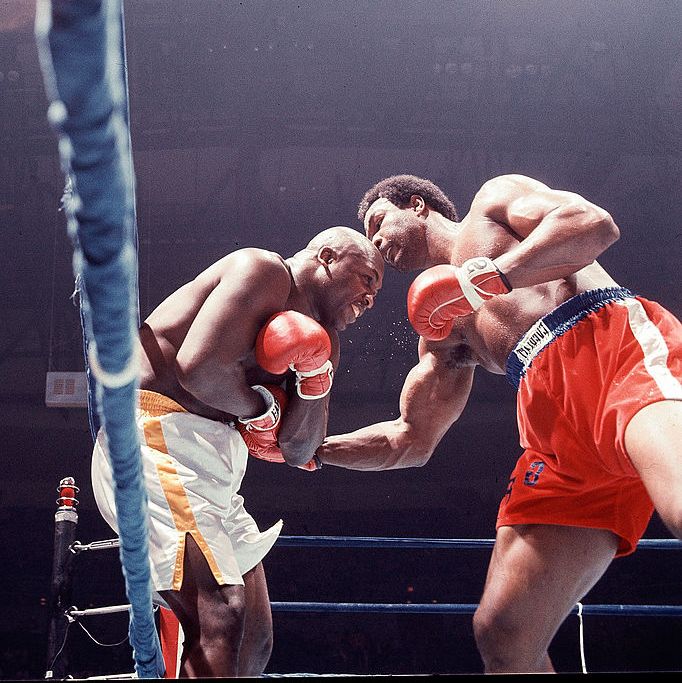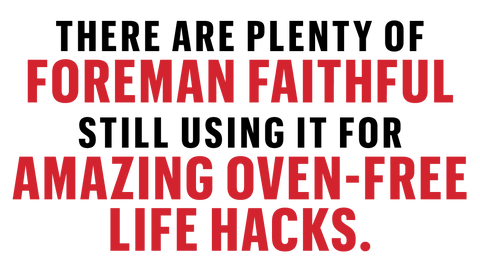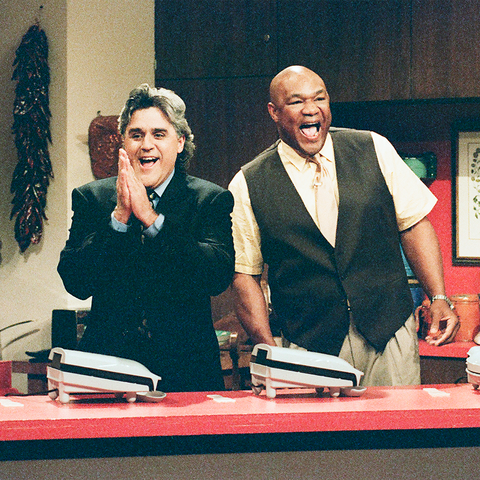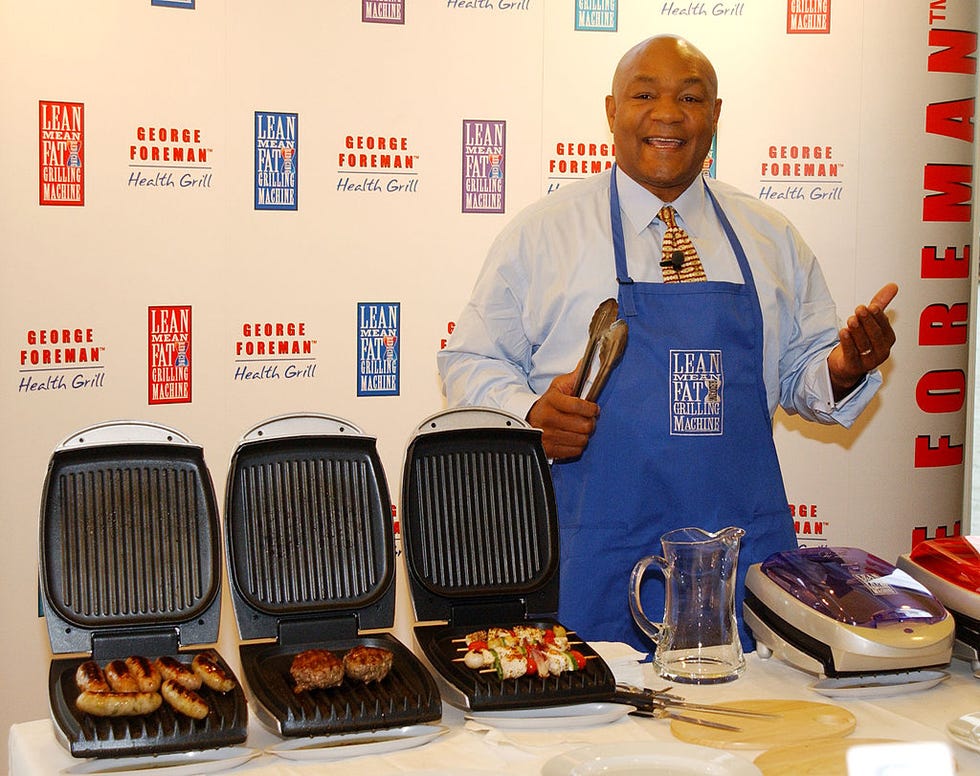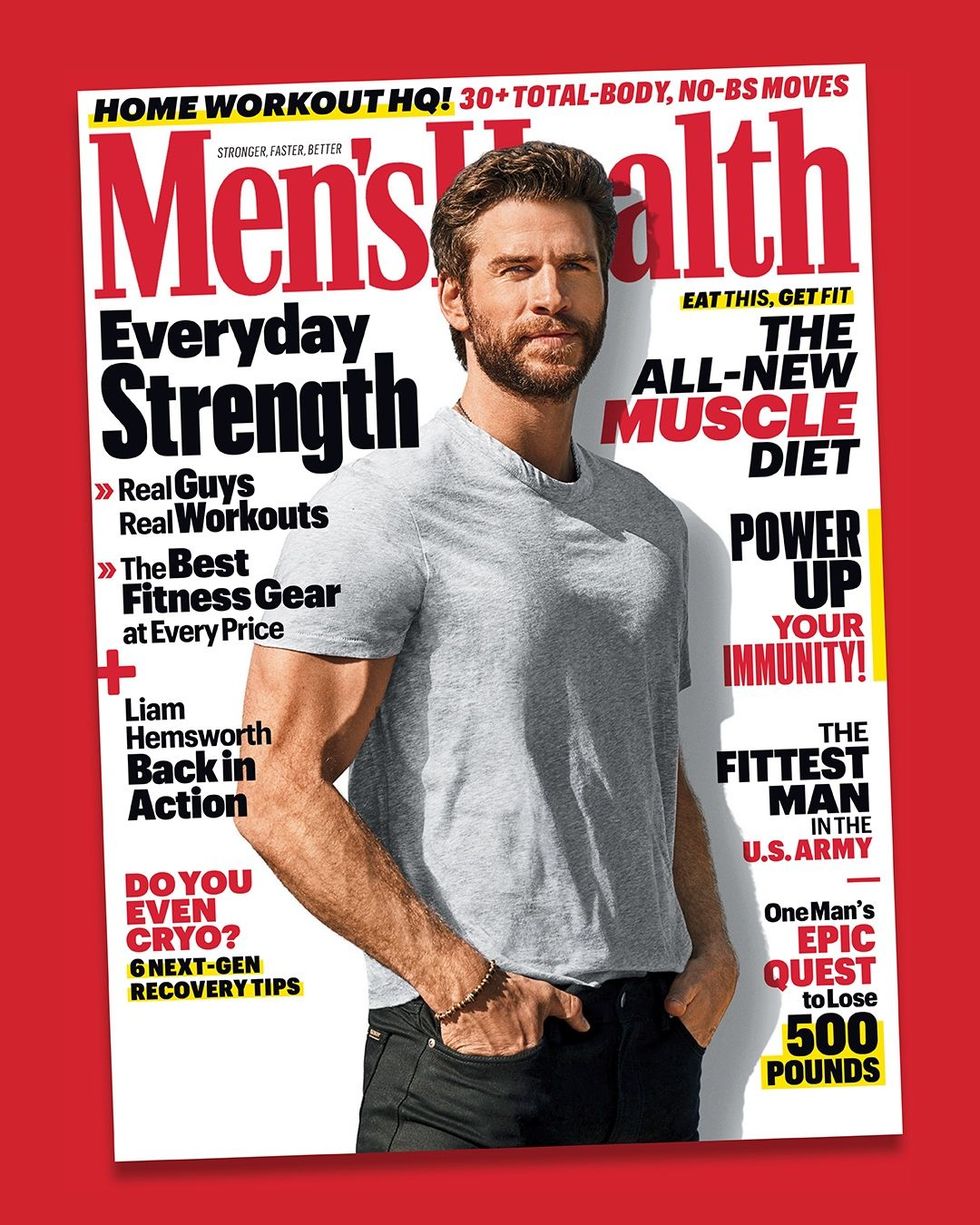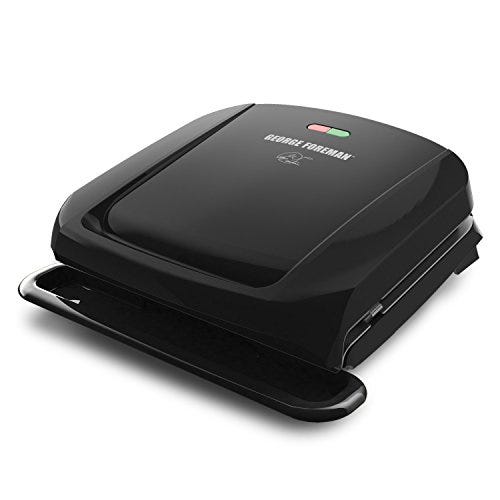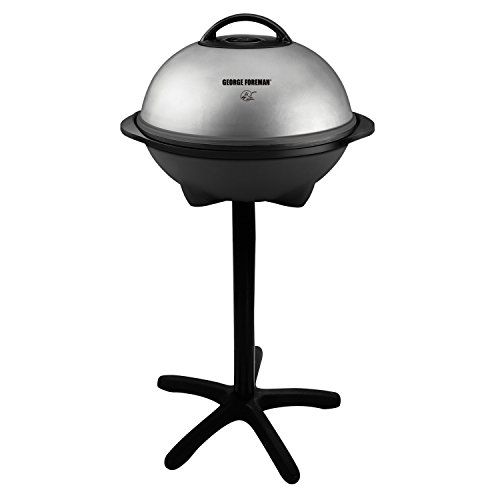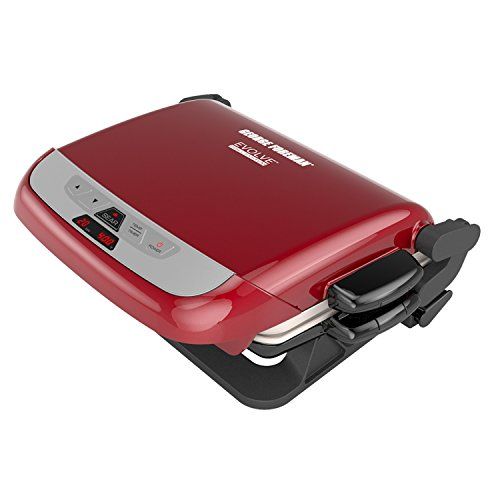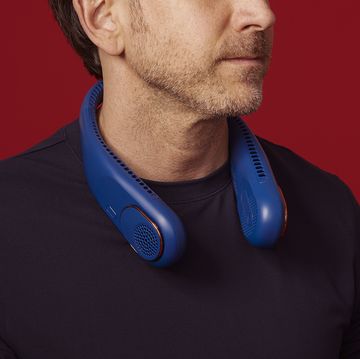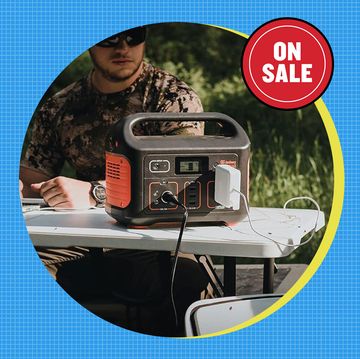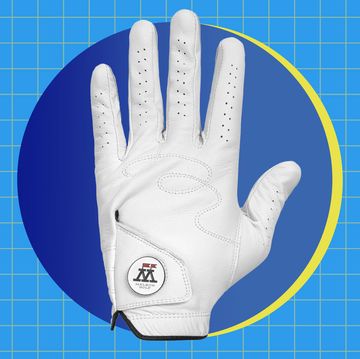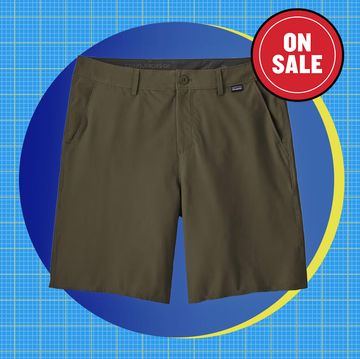IN CASE YOU missed it, this is what the world’s most successful infomercial looks like: George Foreman—buff, bald, and swaggering—sports a maroon boxing robe as he strides into the made-for-TV kitchen of his exceptionally cheerful cohost, a woman named Nancy Nelson. It is 1996, and her mind is about to be blown.
“You did not come here today to box, right?” Nelson asks Foreman.
“Not at all,” he says, before tossing off the robe to reveal that he’s wearing a red apron beneath it. “As a matter of fact—da-da-dada!” (Yes, Big George made his own transformational sound effect. And it worked.)
Over the next 30 minutes, the semiofficial-sounding “George Foreman Grilling Show” introduces the concept of a cheap electric grill with slanted vertical ridges and a press-down lid: George Foreman’s Lean Mean Fat-Reducing Grilling Machine. Plug it in and it gets hot quickly. Toss on some meat, lower the lid, place the tiny grease tray in front, and—voilà! In minutes, your food emerges grease-free and evenly cooked (often well-done,
to be exact).
Foreman hams it up, making clear that his target isn’t Joe Frazier or Ken Norton but burger fat and chicken grease. At one point, he points to his own embossed signature on the top of the device. “Hey, we gonna eat what we want, but we gonna knock the fat out,” he says. Burgers sizzle; the audience oohs and ahhs. This is campy, melodramatic ’90s-era selling at its best.
When the infomercial first hit the air, Foreman was in his mid-40s, fresh off one of the greatest career comebacks in boxing history. He’d won Olympic gold as an amateur in 1968 and gone pro, knocking out Frazier in 1973 to become the heavyweight champion. He was KO’d by Muhammad Ali a year later, and at 28, he retired to become a minister at his own church in Houston. Ten years later, Foreman returned, going on to knock out Michael Moorer, a man nearly 20 years his junior, to reclaim his heavyweight title.
Foreman arrived on our TV sets as a guy who could still go toe-to-toe with anyone, bringing along the promise that there was an easier way to cook healthy and perhaps stay that way. And that one-two punch would spark a cultural shift in how men—or at least this man, and every guy I went to college with—cook and eat.
THE THING IS, George Foreman obviously didn’t invent it. In early 1993, Michael Boehm and Robert Johnson, a designer-engineering duo from Illinois, filed a patent application for an electric cooking device with the lower cooking plate sloped at a 20 degree angle. They called it the Short-Order Grill. In his book The Art of Sales, Marketing & the Spokesperson, Leon Dreimann, then CEO of a kitchen-equipment company called Salton that would purchase the design from Boehm and Johnson, writes that this contraption was originally positioned as a taco/fajita maker. The angled surface meant grilled meats could be scraped directly into a tortilla. He attached the “lean, mean, fat-reducing grilling machine” slogan to play off the “Mean Machine,” Burt Reynolds’s team of rowdy prison footballers in the hit 1974 movie The Longest Yard.
Salton’s other appliances included gizmos like the Juiceman Juice Extractor and the Ron Popeil Pasta Maker. These had complex infomercials in which a pitchman or the actual inventor—generally older, wonky white guys—tried to explain the health, taste, and mechanical advantages of their marvels. Honestly, it worked pretty well (shopping by phone itself was novel), but Dreimann eventually recognized that his grill might catch serious fire if pitched by an already well-known showman. A friend had somehow gotten one to Foreman.
The boxer reportedly wasn’t interested but after playing around with his own recipes finally agreed to some unique terms for a celebrity spokesman: He wanted a back-end cut on sales. Salton would cover the up-front costs and Foreman would take 45 percent of all profits, period. Dreimann agreed, and the grill debuted at the Gourmet Products Show, a cooking trade exhibition in Las Vegas, in 1995, along with an infomercial that opened with 12 seconds of boxing footage featuring Foreman in the ring.
And then: nothing. Sales of the grill were initially sluggish, and 18 months after it came on the market, Dreimann says, a friend’s wife suggested he rethink the infomercial. He replaced the opener with a dad vibe: Foreman making burgers with his children in their home. “On a Tuesday, I flew a film crew to George’s house. It was on air by the following weekend,” Dreimann says. “On Monday, all hell broke loose.”
I BOUGHT MINE, because everyone else had one. As a college freshman in the ’90s, I remember viewing cooking as a one-way transaction: Whatever my parents cooked, I ate. Whatever the school cafeteria near my dorm served, I’d mindlessly scarf down. So goes the calorie-churning metabolism of an 18-year-old. I was always hungry.
There’s a magical quality to the best kitchen appliances. Like a Mr. Coffee or an Instant Pot, the George Foreman grill reduced seemingly complicated cooking procedures to the literal push of a button. (Early versions didn’t even have a button, just a red light to indicate when the cooking surface was hot.)
For all those reasons, Salton at first expected the grill would appeal to seniors who maybe wanted to stay fit yet cut back on their culinary ambitions. But the registration and warranty cards that came back told a different story: The company had a hit with college kids. A big one, and by 1999, Salton was selling $160 million worth of George Foreman grills every year, over the phone and in stores, with the white, spaceship-looking device sitting atop thousands of dorm-room mini fridges across the country.
As many as 150 million units have been sold to date, even with Foreman retiring from the ring in 1997 and later parting ways with Salton. (He declined to be interviewed for this story.) The company went on to sell nearly 90 versions of the grill under the George Foreman imprimatur, and the quintessentially American ideal of cheap convenience went global: Jackie Chan starred in a commercial alongside Foreman to help pitch it in Asian markets. In France, a model came equipped with a function to make steaks “bleu” with a quick burst of heat that browned the outside but kept the interior rare. By conservative estimate, Foreman was probably raking in tens of millions annually. Salton eventually offered him $137.5 million to use his name in perpetuity.
“If not for Nike’s signing of Michael Jordan in 1984, George Foreman’s deal with Salton . . . would undoubtedly be considered the best endorsement deal in sports marketing history,” wrote sports business journalist Darren Rovell in a CNBC analysis in 2010. The formerly impoverished kid who admittedly bullied and mugged people before harnessing that rage ultimately made more from grill sales than he had in the ring. He joined an emerging pantheon of black athletes crossing over to promote everyday products, including O. J. Simpson for Chevrolet and Hertz and Joe Greene for Coca-Cola.
My Foreman grill lived up to the basic hype: It cooked stuff. It also busted once-
villainized fat: In-house tests conducted by Spectrum Brands (which now sells the grill) show that your average patty emerges with a nutritional content similar to that of a burger cooked to medium well that’s been panbroiled and carefully blotted. On basic burger grind, around 40 percent of the fat melts out, minus the hassle.
For me, the true appeal of the Foreman grill was that it was versatile and sort of idiotproof. The same process worked for burgers and pork chops. My first recipes were remedial. I seasoned chicken with salt and then cooked it for 15 minutes to serve with Heinz 57 sauce. Still, it was an important nudge forward in my cooking evolution. For a young guy, the idea of experimenting on an electric, let alone gas, stove was overwhelming, even if I was doing things outside the kitchen seemingly far more reckless.
In recent years, Spectrum has enlisted Food Network personality Jeff Mauro as the grill’s hypeman. He’s over 40, hosts a couple cooking shows, and is a former victor on Food Network Star, a cook-off competition series. Like all the guys I knew in college, Mauro made the grill a staple of his survival. He felt “unencumbered” because he didn’t need a kitchen. “I could cook a burger patty and moments later make a panini,” he says. (In a 2006 episode of The Office, Michael Scott used his to make bedside bacon. He ended up burning his foot.)
In a recent YouTube ad, Mauro doesn’t even waste time showing how it works; he just stands in front of one, riffing on all the kinds of meat he likes (and, okay, some vegetables, too). The protein-centric sales pitch plays to what Americans are hankering for right now while betting that they’re actually willing to go make it. Compared with 1995, it’s estimated that the average American today consumes nearly 20 pounds more meat per year, although poultry is now more popular than beef.
Is it a coincidence that this change occurred at the same time that the George Foreman grill was invading kitchens everywhere? It might be. Or it might not. Either way, a 2018 study in Nutrition Journal showed that over the last decade and a half or so, there’s been a substantial increase in the proportion of men who are cooking, and we’re spending even more time in the kitchen.
THE DESIGN HASN'T been altered much in 25 years, but the George Foreman grill is still a hot commodity. Another 3 million are expected to be sold this year, says Jonathan Schaefer, Spectrum’s vice president of marketing. Yet the grill, which can reach a temperature of 400 degrees, remains essentially a blunt instrument. Its website currently features recipes for tenderloin steak and Greek pork chops alongside recipes for s’mores and peanut-butter banana paninis.
Scour Reddit and YouTube and you’ll find there are plenty of Foreman faithful still using it for amazing oven-free life hacks, like frying an egg (producing strange egg-white tentacles) and making crisp griddled cheese. For his part, Mauro applauds those who use the tool to reheat pizzas. “You also melt the cheese on top,” he says. Someone even solved one of my chief complaints: You can cover both the top and bottom grill surfaces with foil for easier cleaning.
Foreman moved on. He’s pitched us many other products, from Meineke mufflers to Doritos, even selling his own meat via mail order at George Foreman’s Butcher Shop. He recently hawked a pain-relief cream with his own “knockout” formula.
And I guess I’ve moved on, too. I feel nostalgic, but not sad, to say I no longer own a George Foreman grill. Between midlife moves, mine ended up at a secondhand store, the final resting place of countless others. George Foreman didn’t improve my cooking the way a Michael Ruhlman or Alice Waters cookbook did. But he did feed my imagination. He made cooking cheap flank steak something an 18-year-old goof like me could accomplish—no skillet or butter for a Maillard-enabled sear required. That’s about 30 bucks well spent, even if I now prefer both for a nice home-cooked rib eye.

